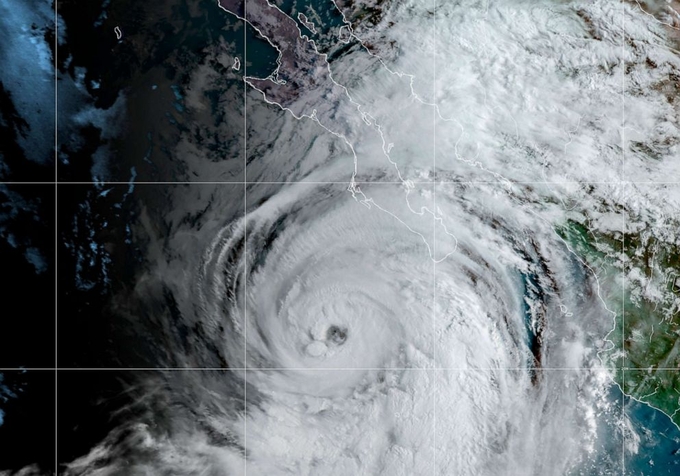November 25, 2025 | 07:37 GMT +7
November 25, 2025 | 07:37 GMT +7
Hotline: 0913.378.918
November 25, 2025 | 07:37 GMT +7
Hotline: 0913.378.918

This satellite image made available by NOAA shows Hurricane Kay off the Pacific coast of Mexico, Sept. 7, 2022.
Changing temperatures around the world have led to several climate emergencies so far in 2022, from historic flooding in Pakistan that's displaced millions of people to the rapid melting of a major glacier in Antarctica.
Parts of the world are expected to experience severe weather for the rest of the year and into 2023, as part of a rare "triple dip La Niña" event, according to the World Meteorological Organization (WMO).
What is the "triple-dip" La Niña?
A "triple-dip" La Niña is a multiyear cooling of the surface temperature of the equatorial Pacific Ocean, which can cause droughts, fierce winds and heavy rainfall.
According to WMO, the current La Niña is projected to span three consecutive northern hemisphere winters. It began in September 2020.
If it continues for the next six months, it will be the first "triple-dip" La Niña event of the 21st century, WMO says.
"It is exceptional to have three consecutive years with a la Niña event. Its cooling influence is temporarily slowing the rise in global temperatures – but it will not halt or reverse the long-term warming trend," Petteri Taalas, the secretary-general of WMO, said in a recent report.
La Niñas are usually preceded by El Niño, a weather pattern that warms the surface of the eastern tropical Pacific Ocean; however, an El Niño event did not occur before the current La Niña, according to Michelle L'Heureux, a climate scientist for the National Oceanic and Atmospheric Administration (NOAA).
Has it happened before? Will it happen again?
While this would be the first "triple-dip" La Niña this century, it's not unprecedented for the weather pattern to last more than nine months to a year, which is typical for a La Niña, according to NOAA.
According to the National Centers for Environmental Prediction, last century, La Niñas occurred several times between 1903 to 2010 and 2010 to 2012.
La Niña's global effect
La Niña occurrences have a devastating global impact because of its effect on weather and climate, Richard Seager, Ph.D., a research professor at Lamont-Doherty Earth Observatory of Columbia University, told ABC News.
The weather has caused droughts in North and South America and equatorial eastern Africa. La Niña is also linked to floods in Asia, such as the devastating floods Pakistan has endured since June, Seager said.
NOAA forecasts that the expected La Niña winter season, which is from December 2022 to February 2023, in the U.S. won't be atypical, as the northern Plains, Rockies and Pacific Northwest will also experience cooler temperatures; the South will be hotter than normal and the East Coast may be warmer than it usually is during that time of the year, according to L'Heureux.
Human-induced climate change?
According to WMO, naturally occurring climate events are viewed as happening because of "human-induced climate change," leading to global temperatures and extreme weather conditions.
"The worsening drought in the Horn of Africa and southern South America bear the hallmarks of La Niña, as does the above average rainfall in South-East Asia and Australasia," Taalas said in the report. "The new La Niña Update, unfortunately, confirms regional climate projections that the devastating drought in the Horn of Africa will worsen and affect millions of people."
According to Seager, it isn't safe to say that the changing climate causes this type of La Niña pattern because it has happened before, but he acknowledges that climate change may play a role.
"The record of sea surface temperatures we have that goes back a century and a half shows that the tropical Pacific Ocean has been moving in the direction that, although it warmed up in the west, it hasn't warmed up in the eastern equatorial pacific," Seager said. "So, that trend in sea surface temperatures is making these persistent La La Niñas more likely."
(ABC News)

(VAN) Brazil's COP30 presidency pushed through a compromise climate deal on Saturday that would boost finance for poor nations coping with global warming but that omitted any mention of the fossil fuels driving it.

(VAN) Poultry farmers in the UK have been warned that they could face one of the worst winters yet for bird flu.

(VAN) Prices of main-crop paddy have risen sharply, with jasmine rice hitting 16,100 baht per tonne — the highest level in years.

(VAN) In Brazil, FAO unveiled a series of reports and initiatives showing how sustainable agrifood systems are a solution to the climate crisis.

(VAN) With names like neodymium and dysprosium, rare-earth elements sound exotic — and their perceived scarcity has only added to the mystique.

(VAN) In a new study published in Trends in Biotechnology, researchers used a gene-editing technology called CRISPR to increase a fungus's production efficiency and cut its production-related environmental impact by as much as 61%- all without adding any foreign DNA.

(VAN) A top official in Beijing’s Cop delegation says China is committed to clean energy – but US’s absence is a problem.